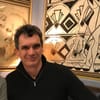Patches, paths & The Matrix: FediCon thoughts Part I

The after hours Fediverse session at FOSDEM 2025 was held at HSBXL - Hackerspace Brussels. A cool, cyberpunk hangout. Wires everywhere, old computers, a fridge full of beer, Belgian goth-punks, and an old fashioned telephone receiver, hanging by its wire from the ceiling. We were in The Matrix.*
In one vision of the Fediverse, this is what servers look like. Hanging telephones hooked up to the Matrix-verse. Servers as nodes. An entry point to wherever you want, and whoever you want to be. There could be hundreds of thousands of people on the server, but you wouldn’t find them in the room. Just a few hackers hanging around. The users are always already down the phone wire, somewhere else, doing their thing. Like Trinity and Neo in the film. Which is a lot of fun, if you know what you’re doing, or if you have the time and patience to become a hacker yourself. Not quite so much fun, if you’re a newbie. You’ll struggle to find the unmarked warehouse in the Brussels backstreet (or be let in the door). You might hang around in the room (which the hackers are going to find awkward). Or struggle to use the phone (embarassing). If you make it through to the Matrix-verse, you’re not going to be flying helicopters or stopping bullets mid-air. You’ll have an existential crisis, feeling completely lost, without any connections, and unable to find anyone to connect with (until the agents lock on to you for some newbie thing you did). You’ll pull the plug and get out.
For a hundred or so hackers in Brussels, Hackerspace is perfect. They’re around 0.000125% of people in the city. The percentage of humans on the Fediverse, as Ben Pate pointed out at FediCon. It's not a coincidence that the two numbers are the same.
Which is where patches and paths come into the story.
Patches are places, not nodes.
A patch of grass to sit with friends for a picnic. A patch of earth turned over to make an allotment. A patch of the city. Our patch. Your patch. Patches create a sense of belonging, of being somewhere. They are liminal spaces, where people and things mix, and value is created, often inadvertently.** Third Spaces, in urban-sociology terms, as introduced to the Fediverse in a stimulating presentation by Johanna B at FediCon.*** Here’s a handy Wikipedia guide to what makes a Third place:
Open and inviting. You don’t need an invitation or appointment, and you can come and go as you please.
Comfortable and informal. You feel that you belong there.
Convenient. It’s close enough to visit often, ideally right in your own neighborhood.
Unpretentious. Everyone is on the same level, there’s nothing fancy or fragile, and it’s not expensive.
There are regulars. And often there’s a host who greets people as they arrive.
Conversation is the main activity. Discussion, debate, and gossip are part of the mix.
Laughter is frequent. The mood is light-hearted and playful.
At FediCon, as much happened in the cafes, bars and lobbies around the conference hall as during the talks. Lots of servers in the Fediverse are patches, or Third Spaces. They’re communities. Like the Canadian instances at FediCon, local instances like toot.wales, servers allied to different groups, and servers for topical interests. But without fresh waves of new users, many of these Fediverse patches are slowly declining. We need to find ways to reverse this, and learn from the handful of growing servers, like qlub.social or mastodon.de.
Paths are adventurous. Paths go places. Make connections.
Paths can take you all over the world, or round the corner. Narrow paths, where everyone nods and says hello; broad paths, where everyone is carrying a placard or shouting a slogan. We’re lucky to have the inventor of the hashtag, Chris Messina, in the Fediverse. Hashtags offer a pathway through the verse, the one thing to hold on to if you find yourself uploaded through that hanging phone. Over at Bluesky and Farcaster, there are super-powered versions of the same concept: Custom Feeds and Channels. Dan Ramero of Farcaster calls Channels ‘cosy corners’. Jay Graber of Bluesky loves the Moss Feed. In the on-chain world, or the Bluesky firehose, Channels and Custom Feeds offer a break from the noise. At the other end of the scale, Rudy Fraser has turned Blacksky into a powerhouse community which started off inside Bluesky, and is now finding its own way in the ATmosphere.
Put some paths inside and around the Berlin hacker space, and you don’t have to disappear into the black hole of the Matrix. You can go places, bump into people and discover new patches to hang out in.
Connected spaces.
Despite much hang wringing over Fediverse onboarding, the answer isn’t a single entry point into the Matrix-verse, nor even random rotating servers (a nice idea from Tim Chambers). Connections need to begin before people join, so that they arrive already comfortable, at home, and welcome. Joining a local Facebook group does this. A friend mentions the group to you, you check it out, and as soon as you see that someone on your street has a missing cat, you’re at home. It’s fluffy, comfortable and super-sticky. The opposite of the black hole provided to new Fediverse joiners. Local and topical servers can do this, as can feed based communities like Blacksky. Or onboarding people from one the millions of existing websites, as proposed by Johannes Ernst. With apps as entry points, not add-ons.
Joining the Fediverse isn’t a difficult, unpleasant experience by mistake. It’s by design.
New users are sucked into a black, blank Matrix-verse which is itself a simulacra. We need to unplug ourselves, touch grass, plant seeds, get our feet wet, hold parties, mount expeditions. Make patches and explore paths. Create, find and enjoy Third Spaces.
We can have a different social web, if we want it.
Notes
First thoughts from FediCon, a vibrant Fediverse gathering in Vancouver on 1-2 August 2025, put together by Charles Reiver and team. Part II and III to follow. Thank you to everyone who organised, presented and attended. It was fun!
*This blog post assumes you've seen The Matrix. If you’ve not, picture awesome people dressed in black discovering life is all a computer simulation, and wreaking havoc.
**Anna Tsing, The Mushroom at the End of the World.
***Ray Oldenburg and Karen Christensen, The Great Good Place.
